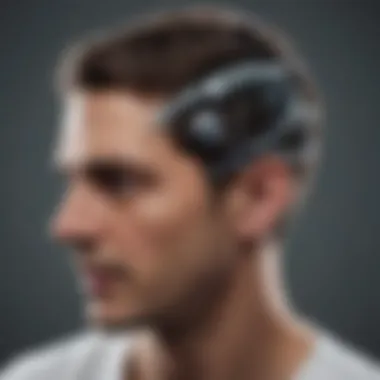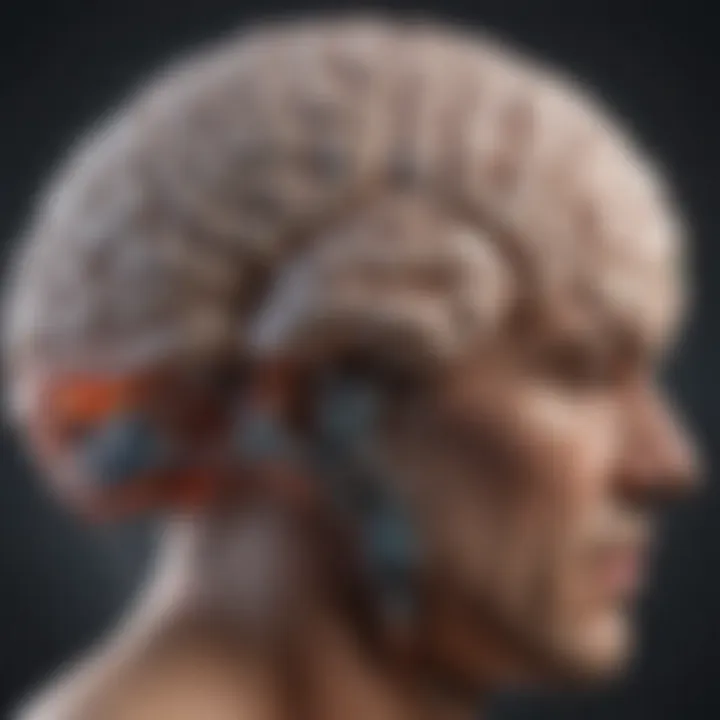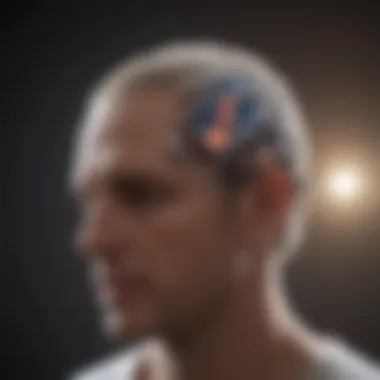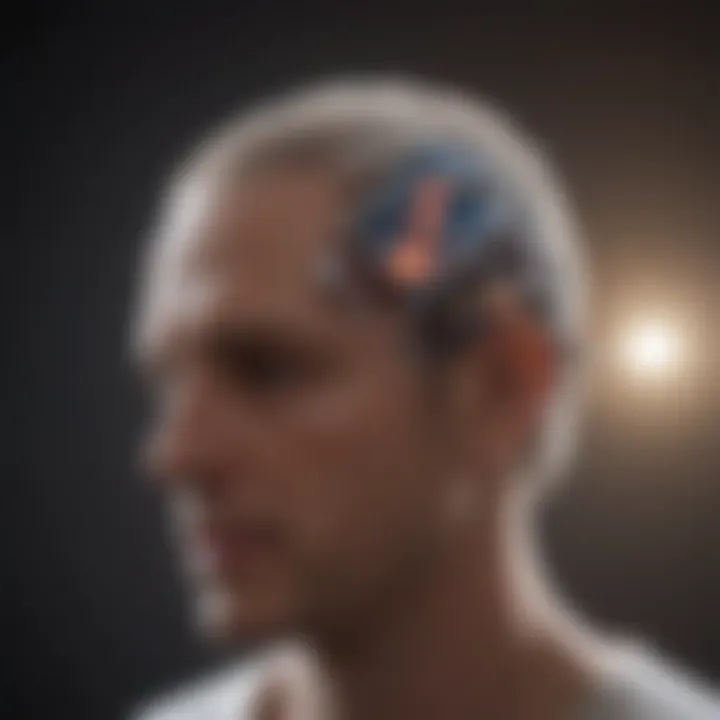Innovative TMS Treatment Approaches for Epilepsy


Intro
In the realm of neurological treatment, Transcranial Magnetic Stimulation (TMS) stands as an innovative approach that piques interest among researchers and clinicians alike. Notably, TMS provides a non-invasive method to stimulate specific areas of the brain, particularly the cortical structures involved in seizure genesis and modulation in epilepsy. The mechanics behind TMS are decidedly intricate, yet its potential as a therapeutic option is substantial.
As epilepsy continues to be a challenging disorder to manage, the exploration of TMS within this context opens avenues for enhanced patient care. While existing treatments, such as antiepileptic drugs, remain standard, not all patients respond favorably. Hence, the quest for alternative strategies, like TMS, becomes paramount. This article endeavors to illuminate the multifaceted aspects of TMS and its implications for epilepsy treatment.
Through a careful examination of recent research, efficacy, safety, and the theoretical underpinnings of TMS, this narrative seeks to provide a well-rounded perspective. It is crucial for readers—be they students, educators, researchers, or healthcare professionals—to gain a deeper appreciation of how TMS might redefine therapeutic approaches to epilepsy.
Research Overview
Background and Context
Epilepsy affects millions globally and, despite advancements, finding effective treatments remains a perpetual hurdle. Traditional management strategies often fall short, leaving many patients grappling with persistent seizures and diminishing quality of life. Recent trends in neuromodulation highlight TMS as a contender in this complex landscape.
TMS operates by generating magnetic fields that induce electrical currents in the brain. These currents target specific areas, potentially inhibiting or promoting neuronal activity. The capacity of TMS to modify brain circuits opens the door to exploring its application in epilepsy—a condition characterized by abnormal neuronal excitability and synchrony.
"TMS could revolutionize the approach we take in treating epilepsy, offering a glimmer of hope for patients who have exhausted conventional options."
Summary of Key Findings
Emerging studies suggest that TMS could not only reduce seizure frequency but also enhance cognitive functions adversely affected by recurrent seizures. Several key findings from research indicate:
- Markable Reduction in Seizure Frequency: Many studies report a statistically significant decrease in seizure occurrences following TMS therapy.
- Enhanced Neuropsychological Performance: TMS appears to benefit cognitive functions in certain epilepsy patients, particularly those with frontal lobe seizures.
- Safety Profile: Generally, TMS is well-tolerated, with minimal side effects, which contrasts favorably against traditional pharmacological interventions.
By honing in on these findings, this article prepares to explore the methodologies employed in TMS research, illustrating the intricate dance between discovery and therapeutic potential.
Prolusion to TMS Treatment
Transcranial Magnetic Stimulation (TMS) stands at the frontier of neurological treatments, garnering attention for its potential to reshape the landscape of epilepsy management. Understanding TMS is crucial in this context, as it embodies a non-invasive technique that could provide fresh hope for those affected by difficult-to-treat seizure disorders.
TMS utilizes magnetic fields to stimulate nerve cells in the brain, paving the way for a plethora of benefits. Some key aspects to consider when diving into this topic include its mechanism of action, safety profile, and the versatility of its applications. The non-invasive nature of TMS makes it an attractive alternative to traditional treatments, reducing the risk of complications that often accompany surgical options.
Moreover, TMS treatment is not just a one-size-fits-all solution. Patients may find personalization in their treatment plans vital. This adaptability could enhance efficacy, opening doors to better outcomes for individuals seeking relief from their condition. Additionally, understanding the broader implications of TMS could further enlighten healthcare professionals about integrating it into existing therapeutic frameworks.
Drilling down into the essence of TMS highlights its underlying principles and the historical trajectory that shaped its evolution in neurology. Careful examination of these elements lays a solid foundation for grasping TMS's role in handling epilepsy.
Defining Transcranial Magnetic Stimulation
Transcranial Magnetic Stimulation, or TMS, is a technique that employs magnetic fields to modulate the activity of neurons in the brain. This is accomplished by placing an electromagnetic coil near the scalp, generating brief but powerful magnetic pulses. These pulses reach the brain's surface, inducing electrical currents that can alter neuronal behavior.
TMS can be aimed at specific cortical areas, making it an invaluable tool for researchers and clinicians alike. It operates on the principle that the targeted brain region can be influenced without requiring any invasive procedures. Such non-invasiveness is a standout feature, particularly in a medical landscape which often hinges on more aggressive interventions like surgery.
"The beauty of TMS lies in its ability to bridge the gap between pharmacological approaches and surgical interventions, offering a middle ground for patients navigating epilepsy treatments."
The flexibility of TMS allows it to play a role not just in treating conditions like epilepsy, but also in a variety of other neurological and psychiatric disorders. As the scientific community continues to explore its breadth, the definition of TMS evolves, gaining dimensions that foster a deeper understanding of cerebral functionality.
Historical Context of TMS in Neurology
The journey of TMS in neurology is fascinating, tracing back to its inception in the late 1980s. Initially, TMS was employed primarily as a research tool to elucidate brain functions and pathways. Early experiments revealed that magnetic stimulation could evoke muscle contractions, setting the stage for its eventual clinical applications.
In the years that followed, TMS steadily garnered validation through rigorous scientific inquiry. Within a relatively short span, it transitioned from an experimental device to an established technique for conditions like major depressive disorders, anxiety, and now, epilepsy. This shift not only underscores its adaptability but also points to the growing acknowledgment of its therapeutic potential.
The increased focus on TMS within the clinical setting parallels advances in neuroimaging technologies and neuroscience. As these fields advanced, they laid a framework for utilizing TMS in revealing mechanisms of action and crafting targeted interventions. Evaluative research linking TMS with seizure management has gained momentum, indicating a strong future direction for this treatment modality in neurology.
In summary, the historical context enrichens the understanding of TMS, emphasizing its evolution from merely a research tool to a versatile intervention. For anyone interested in neurology, appreciating this timeline is essential for grasping the potential that TMS holds in reshaping treatment methodologies for epilepsy and other disorders.
Understanding Epilepsy
Understanding epilepsy is foundational to appreciating how Transcranial Magnetic Stimulation (TMS) can serve as a potentially transformative treatment modality. Epilepsy is not merely a singular condition but a complex collection of disorders, each with its own nuances and clinical presentations. Dipping into this topic helps to grasp various challenges associated with the condition, its variability, and, ultimately, why effective treatments are so critical. Understanding epilepsy’s spectrum aids researchers and clinicians in tailoring treatments and provides insights that may influence future TMS applications.
Types and Classification of Epilepsy


Epilepsy can manifest in myriad ways, hence its classification into various types is essential for effective management. Broadly speaking, epilepsy is divided into two primary categories: focal and generalized seizures.
- Focal Seizures: These arise in a specific area of the brain. An individual experiencing a focal seizure might remain aware of their surroundings, which is termed a focal aware seizure. However, if their awareness is compromised, it's identified as a focal impaired awareness seizure.
- Generalized Seizures: These affect both hemispheres of the brain right from the game's onset. Examples are absence seizures—often characterized by brief lapses in awareness—and tonic-clonic seizures, known for comprising body stiffness followed by rhythmic jerking movements.
Additionally, epilepsy can be classified by several criteria, including the cause, which may be genetic, structural, or metabolic. This classification can help determine the trajectory of treatment options available to a patient.
Pathophysiology of Seizures
Seizures stem from abnormal electrical activity in the brain. To break it down further, we have to understand neuronal excitability—the tendency of neurons to fire abnormally. A deficiency in inhibitory signals from surrounding neurons can lead to a cyclical cascade of hyperexcitability, which is essentially the hallmark of seizure disorders.
- Neurotransmitter Imbalance: The balance between excitatory neurotransmitters like glutamate and inhibitory ones like gamma-aminobutyric acid (GABA) plays a critical role here. An excess of glutamate may push the threshold conducive to seizures.
- Hyper-synchrony: In simpler terms, this is when a large number of neurons in a given area begin firing off in synchrony, akin to a well-rehearsed choir—only in this case, it’s mere chaos that ensues.
The pathophysiological processes underlying seizures can vary widely among individuals. Understanding these mechanisms is essential as they lay the groundwork for why certain treatments, like TMS, may be effective. TMS has the potential to recalibrate these paths, working to decrease the hyperexcitability that leads to seizures.
"As we continue to unravel the complexities of epilepsy, the quest for knowledge does not only illuminate the path for innovation but also empowers those affected to seek tailored therapeutic options."
In summary, looking into epilepsy helps paint the full picture of the condition, its different types, and the mechanisms that lead to its symptoms, setting the stage for exploring TMS and its implications in treatment.
Mechanisms of TMS
Transcranial Magnetic Stimulation (TMS) represents a groundbreaking approach in neurotherapeutics, particularly in the management of epilepsy. Understanding the mechanisms underlying TMS is vital, as these elements contribute directly to its therapeutic potential and efficacy. By comprehending how TMS works, health professionals can better tailor treatment protocols to suit individual patient needs, potentially leading to improved outcomes.
TMS involves non-invasive stimulation of the brain's cortical structures, utilizing electromagnetic induction to induce electrical currents in specific brain regions. As a result, it becomes essential to dissect the various principles and impacts that the technique incorporates to inform both clinical practice and ongoing research in epilepsy treatment.
Basic Principles of TMS
At the heart of TMS lies a relatively straightforward principle: the induction of electrical currents through the application of magnetic fields. A coil is placed on the scalp, and when a rapidly changing electric current flows through this coil, it generates a magnetic field, which in turn induces a small electrical current in the underlying brain tissue. This basic mechanism is crucial in understanding how TMS can modulate neuronal activity, as the induced currents can either excite or inhibit cortical neurons, depending on the parameters set during the TMS session.
This principle enables the manipulation of cortical excitability, which is paramount when considering treatment options for conditions that feature abnormal brain activity, such as epilepsy. Thus, clinicians must consider the parameters of stimulation, including intensity, frequency, and duration, to achieve the desired therapeutic outcomes.
Impact on Cortical Excitability
Cortical excitability refers to the propensity of neurons to fire and communicate with neighboring neurons. Within the context of epilepsy, pathways with heightened excitability may contribute to seizure activity. TMS has the capacity to modulate this excitability. When applied correctly, TMS may reduce the excitability of hyperactive areas or enhance the function of underactive regions.
The ability to alter cortical excitability not only opens new avenues in therapeutic interventions but also raises questions about patient-specific responses. Each individual might exhibit varying levels of cortical excitability, so understanding these variations is necessary for customizing TMS treatments effectively. Research has shown that the judicious application of TMS can lead to a reduction in seizure frequency and severity among patients, highlighting its potential as a key component of epilepsy management.
"TMS addresses the fundamental electrical activity of the brain, providing clinicians not just a tool, but a partner in reshaping neuronal interactions."
Modulation of Neural Circuits
The brain functions as an intricately connected network, where multiple circuits interact to facilitate complex processes, including movement, cognition, and emotions. TMS has the potential to modulate these circuits, amplifying or dampening specific neural pathways. For epilepsy patients, this modulation is particularly relevant, as abnormal synchronization of neural circuits is often implicated in seizure phenomena.
By targeting specific areas associated with seizure generation or propagation, TMS may disrupt these abnormal circuits, fostering a balance that can reduce the incidence and severity of seizures. The precision with which these circuits can be influenced underscores the technology's promise in personalized medicine. For instance, patients with temporal lobe epilepsy may differ significantly from those with generalized epilepsy in terms of excitability patterns and circuitry involved, necessitating tailored approaches that consider these variations.
Integrating the fundamental mechanisms detailed above positions TMS not merely as a treatment modality, but as a transformative paradigm in epilepsy management, unlocking the potential for tailored therapeutic strategies based on individual neural profiles.
Clinical Applications of TMS in Epilepsy
The clinical applications of Transcranial Magnetic Stimulation (TMS) in the realm of epilepsy are gathering attention, and for good reason. As a non-invasive intervention, TMS not only provides insights into brain functionality but also holds promise as a therapeutic strategy for individuals who are resistant to traditional treatments. This section aims to articulate the significance of TMS in clinical practice, focusing on diverse protocols, efficacy in seizure reduction, and its complementary role alongside other treatment modalities.
Overview of TMS Protocols for Epilepsy
The protocols for applying TMS in epilepsy involve a structured approach tailored to individual patient needs. Generally, the procedure consists of directing magnetic pulses at specific regions of the brain, primarily the motor cortex. Here’s a general outline of how these protocols operate:
- Frequency and Duration: Frequencies can vary, typically ranging from low-frequency (1 Hz) to high-frequency (5 Hz or greater), depending on the desired outcome. Sessions may last anywhere between 20 to 30 minutes.
- Target Area: Specific brain areas are targeted based on the patient’s unique seizure profile. The motor cortex is often involved, yet some protocols aim at the prefrontal cortex or other regions implicated in the seizure circuitry.
- Repetitive TMS (rTMS): This involves delivering a train of magnetic pulses. For instance, studies often utilize rTMS in 5-day sessions over several weeks, assessing the iterative impact on seizure frequency and general brain function.
"The structured application of TMS can individualize treatment, paving ways for personalized therapies that address the unique challenges faced by epilepsy patients."
Understanding the intricacies of these protocols allows healthcare providers to optimize TMS application based on patient profiles, leading to more efficacious outcomes.
Efficacy in Reducing Seizure Frequency
Empirical evidence indicating the efficacy of TMS in lowering seizure frequency is steadily accumulating, marking TMS as a compelling option for patients who may not find relief through conventional pharmacological treatments. Clinical trials have demonstrated that:


- Reduction in Seizures: A significant number of patients experienced a reduction in seizure frequency after several TMS sessions. Reports indicate that some participants noted a decrease in over 50% of seizures, which is quite remarkable for those battling intractable forms of epilepsy.
- Duration of Effects: While immediate reductions in seizure frequency are notable, the sustainability of these effects post-treatment provides essential data. Some studies suggest that benefits can persist for months following the conclusion of the TMS regimen.
- Neurophysiological Changes: It’s not merely about numbers; neurophysiological improvements have been documented, suggesting increased cortical inhibition and overall brain adaptability are contributing factors in seizure modulation.
All these considerations create a strong case for TMS as a suitable treatment choice, especially for patients seeking alternatives.
TMS as Adjunct Therapy
Considering TMS as an adjunct therapy illustrates the intersection of various treatment strategies in managing epilepsy. Rather than replacing existing therapies, TMS can enhance therapeutic efficacy through:
- Complementary Benefits: When combined with antiepileptic medications, TMS may boost the overall effectiveness while potentially allowing for lower doses of medication. This approach might mitigate various side effects associated with higher dosages, which is often a concern in standard treatment paradigms.
- Addressing Comorbid Conditions: Many individuals with epilepsy experience anxiety, depression, or other psychological conditions. TMS may assist in concurrently addressing these comorbid factors, leading to improved overall quality of life for patients.
- Holistic Treatment Plans: By integrating TMS into multi-faceted treatment plans, physicians can adopt a holistic view of patient care. This strategy not only tackles seizure management but also engages in broader mental health considerations, which are crucial in the epilepsy care landscape.
Investigations and Recent Research
Importance of Investigations and Recent Research
In the realm of transcranial magnetic stimulation (TMS) for epilepsy, the investigation of its mechanisms, efficacy, and safety is crucial. As this non-invasive treatment gains traction, ongoing research acts as a lighthouse guiding practitioners and patients alike through uncharted waters. Understanding the nuances of TMS helps address various elements: the varying responses among individuals, the optimal treatment parameters, and the implications these findings have on clinical practices. It’s not just a game of guessing what works; it’s about pinpointing effective strategies that can be tailored to specific patient needs.
Research studies often serve as the backbone in establishing TMS as a valid therapeutic option. They not only explore how TMS interacts with cortical excitability but also shine light on the broader impacts it may have on seizure management, demonstrating that methods can evolve alongside the science. Thus, delving into recent trials and noteworthy case studies offers a richer, more nuanced understanding of TMS's role in epilepsy management, keeping the conversation grounded in scientifically sound methodologies.
Current Trials on TMS and Epilepsy
The landscape of clinical trials concerning TMS and epilepsy is steadily expanding. A number of studies are underway, each targeting different facets of how TMS can alleviate the burden of seizures. For instance:
- Phase I and II Trials: These trials primarily focus on determining the efficacy and safety of TMS protocols among varied epilepsy populations. Participants sprawl from adults with drug-resistant epilepsy to children with atypical seizure presentations.
- Targeted Protocols: Specific studies are investigating tailored TMS frequencies and session durations - some probing into the comparative effectiveness of high-frequency versus low-frequency stimulation.
- Biological Markers: Investigations are also geared towards identifying genetic or electrophysiological markers that could predict individual responses to TMS, paving the way for personalized medicine.
To put it plainly, current trials are foreseeing the horizon by merging practical application with innovative research. These multidimensional approaches underscore the complex interplay between clinical practice and ongoing science, providing a framework for improving treatment outcomes.
Success Stories and Case Studies
Success stories stemming from TMS treatments illuminate the potential impact on patients' lives and provide a tangible perspective on its efficacy. While success can be subjective, these case studies contribute vital anecdotes that inform broader clinical perspectives. For example:
- Patient A: An adult diagnosed with temporal lobe epilepsy had previously experienced debilitating seizures several times a week. After undergoing a series of TMS sessions, the patient reported a significant reduction in frequency and severity, leading to a marked improvement in quality of life. This individual case supports findings from similar studies about TMS's potential in mitigating seizures.
- Patient B: A child with Lennox-Gastaut syndrome displayed minimal improvement after conventional treatments. Post-TMS intervention, the child’s parents noted a visible increase in alertness and cognitive engagement, showcasing improvements beyond mere seizure control.
Each success story reinforces the notion that TMS may play a meaningful role in epilepsy management and that patient experience remains an essential facet of understanding treatment impact.
These narratives, anchored in detailed reporting and clinical reflections, serve not just to inspire hope but also to motivate ongoing inquiry in both clinical and research settings. As the data accumulate, the broader narrative around TMS will continue to evolve, offering fresh insights that future studies can build upon.
In summary, the investigations and case studies in TMS present a compelling glimpse into a burgeoning field, reinforcing that while challenges remain, the potential for innovative therapies like TMS in managing epilepsy is not just a hopeful prospect—it is becoming a tangible reality.
Safety and Side Effects of TMS
When considering any medical treatment, especially ones related to brain stimulation like Transcranial Magnetic Stimulation (TMS), understanding safety and side effects is paramount. This section sheds light on the safety profile of TMS, its common side effects, and the contraindications that need to be accounted for before commencing treatment. Recognizing these elements ensures that TMS can be utilized effectively while minimizing potential risks to the patient.
Safety Profile of TMS Procedures
TMS is generally regarded as a safe procedure when executed under proper clinical supervision. The non-invasive nature of TMS is one of its major selling points. Unlike surgical interventions, TMS does not require anesthesia and poses a significantly lower risk of complications.
In a clinical setting, protocols have been developed to ensure patient safety. These include pre-treatment assessments that involve evaluating the patient’s medical history and current health status. Some key points regarding the safety profile of TMS include:
- Non-invasive approach: TMS uses magnetic fields to excite neurons, avoiding the need for physical intrusion.
- Minimal recovery time: Patients can usually return to their daily activities immediately after a session.
- No serious long-term side effects: Compared to many pharmacological treatments, TMS does not have a lengthy list of serious side effects.
Most studies indicate that adverse effects are rare, but it is crucial to stay vigilant as individual responses can vary.
Common Side Effects
While TMS is generally safe, it’s not entirely without side effects. These side effects tend to be mild and transient, often resolving shortly after treatment.
Some commonly reported side effects include:
- Headaches: This is the most frequently reported side effect, usually mild and easily managed.
- Discomfort at the stimulation site: Patients might feel a tingling sensation during the procedure, which typically dissipates quickly.
- Fatigue: Feeling unusually tired after a session is sometimes noted, but most patients recover rapidly.
- Mood changes: Some individuals may report slight fluctuations in mood, although these are generally temporary.
It's noteworthy that while these side effects are not uncommon, most patients tolerate the treatment well, viewing the benefits as outweighing any transient discomfort.
Contraindications for TMS Treatment


Despite TMS’s overall safety, there are specific contraindications that necessitate caution or complete avoidance of the treatment. Certain health conditions can make TMS unsuitable for some individuals.
Key contraindications include:
- Seizure disorders: Patients with a history of seizures that are not well controlled should avoid TMS, as the treatment may potentially provoke seizures.
- Presence of metallic implants in the head: Any implants that might interfere with magnetic fields, like certain aneurysm clips or cochlear implants, are a strong contraindication.
- Psychiatric disorders: In some cases, individuals with certain psychiatric conditions might not be ideal candidates due to potential adverse effects on their mental state.
- Pregnancy: The safety of TMS during pregnancy has not been fully established, prompting some practitioners to err on the side of caution.
With these contraindications recognized, it's essential for practitioners to conduct thorough evaluations and considerations prior to initiating TMS treatment.
"Safety is not a gadget, but a state of mind."
Understanding the ramifications of these safety concerns make it apparent that while TMS presents a promising treatment for epilepsy, patient selection and monitoring are indispensable in navigating its implementation. Ensuring a good fit for the treatment can help mitigate risks and enhance therapeutic outcomes.
Future Directions for TMS in Epilepsy Management
The landscape of neurological treatment is continuously evolving, with Transcranial Magnetic Stimulation (TMS) standing at the forefront. As we focus on the future directions of TMS in epilepsy management, it’s vital to understand not just where we are, but where we’re headed. The incorporation of TMS provides a fresh perspective on managing epilepsy, lending itself to non-invasive methodologies that minimize the complications normally associated with traditional interventions.
The benefits of expanding TMS applications are manifold. For one, non-invasiveness is a significant advantage, especially for patients who may not respond well to pharmacological treatments or are wary of surgical options. By leveraging TMS, we can provide an treatment option that reduces patient anxiety and encourages adherence to therapy.
Moreover, we need to consider the tailoring of treatments to individual patient profiles. Each person experiences epilepsy differently, and future research aims to fine-tune TMS protocols that align with unique neural networks and seizure types. Such customization could enhance the effectiveness of TMS, paving a new road for personalized medicine in neurology.
Innovations in TMS Technology
Technological advancements constantly reshape our understanding and application of TMS for epilepsy management. Future innovations might include refined stimulation techniques, such as high-definition TMS or the use of different coil designs that enhance focality. The ultimate goal is to increase effectiveness while minimizing discomfort during sessions.
Additionally, integrating brain-computer interfaces with TMS shows potential for groundbreaking advancements. This fusion may allow real-time monitoring of seizure activity, offering a greater understanding of how TMS can be optimally applied during a patient's susceptible periods. Imagine a TMS device that could be activated at the onset of a seizure, altering its trajectory before it fully manifests—these innovations push the envelope of possibility.
Another avenue worth exploring is the incorporation of machine learning algorithms. These algorithms could analyze vast amounts of patient data to determine which TMS protocols are most effective for specific seizure types or individual patient characteristics.
TMS and Personalized Medicine
Personalized medicine, a concept that’s gaining steam across many medical fields, is especially promising when paired with TMS. The notion is simple: tailor treatment strategies based on individual patient data, rather than adopting a one-size-fits-all approach. With TMS as a backdrop, we begin to see how precision medicine might play out.
Adapting TMS protocols according to genetic, metabolic, and environmental factors can lead to more successful outcomes. Identifying biomarkers specific to epilepsy could aid in determining which patients would benefit most from TMS interventions. If researchers can pinpoint factors that predict response to TMS, it could revolutionize patient selection and treatment effectiveness.
Moreover, the intersection of TMS with genetic studies offers a fertile ground for exploration. Research into how individual genetic variations affect neural plasticity could inform treatment decisions, enhancing our ability to provide efficient care tailored to each patient's needs.
"The future of TMS lies in its ability to evolve beyond the conventional, making it a cornerstone of epilepsy treatment strategy."
As we forge ahead, collaboration between neurologists, researchers, and technology developers will be key. By amalgamating knowledge from diverse fields, there’s potential not just to change how epilepsy is managed, but to enhance overall patient quality of life.
In summary, the future of TMS in epilepsy management is bright, with innovations in technology and a move towards personalized medicine holding the potential to redefine treatment paradigms. Researchers are on a constant quest for improvements, and it’s exciting to think of where we could be in the years to come.
Comparative Analysis with Other Treatments
When delving into Transcranial Magnetic Stimulation (TMS) as a treatment for epilepsy, it's crucial to position this novel approach within the larger framework of existing therapies. A comparative analysis provides invaluable insights into how TMS stacks up against traditional treatments, such as pharmacological approaches and surgical interventions. Understanding these differences not only assists patients and caregivers in making informed decisions but also helps practitioners determine the most suitable course of action based on individual patient profiles.
In this section, we explore two primary modalities: pharmacological approaches and surgical interventions. Each has its distinct benefits, drawbacks, and mechanisms of action, and understanding these can illuminate the potential role of TMS in epilepsy management.
TMS Versus Pharmacological Approaches
Pharmacological treatments for epilepsy often take the form of antiepileptic drugs (AEDs), and these have become the first-line option for many individuals. These medications aim to adjust the imbalance of excitatory and inhibitory neurotransmitters in the brain to decrease seizure frequency. Some of the common medications include:
- Carbamazepine
- Levetiracetam
- Valproate
Despite their effectiveness, AEDs come with their fair share of complications. Side effects can range from mild, such as fatigue and dizziness, to severe, involving cognitive impairment or adverse reactions that necessitate change in therapy. Moreover, about 30% of epilepsy patients experience drug-resistant seizures, often leading them to seek alternative therapies. This is where TMS presents a compelling option by offering a non-pharmacological approach that targets brain function directly without altering the chemical balance through medication.
TMS can be particularly appealing because it is generally well tolerated, with fewer side effects compared to AEDs. The benefit of modulating cortical excitability without pharmacological manipulation can lead to a better quality of life for individuals who struggle with the side effects of traditional medication. More studies are needed, but initial research suggests that TMS might significantly reduce seizure frequency, offering a promising adjunct to existing medical treatments.
TMS Versus Surgical Interventions
Surgical options are typically reserved for cases of refractory epilepsy where patients do not respond to medication. Procedures may include lobectomy, where a section of the brain is removed, or more targeted techniques like responsive neurostimulation. While surgery can yield dramatic results, it’s not without risk. Potential complications include infection, cognitive changes, and, crucially, the irreversible nature of the intervention.
In contrast, TMS is non-invasive and reversible. It offers a chance to alter brain activity without the surgical risks associated with permanent interventions. Not all patients are candidates for surgery, so TMS may serve as a viable alternative for these individuals. The adaptability of TMS—allowing for personalized adjustments in treatment plans—could lead to enhanced outcomes.
"TMS may serve as an exciting bridge between medication management and surgical solutions, filling a crucial gap for those caught in the crossfire of epilepsy treatment options."
Summary
In summation, TMS presents a fascinating alternative when compared to traditional pharmacological and surgical treatments for epilepsy. While AEDs can effectively manage seizures for many, their side effects may prove intolerable for some patients. Similarly, surgical interventions, while potentially life-altering, come with considerable risks and are not suitable for everyone. TMS provides a non-invasive option that empowers both patients and clinicians to consider new methods in an evolving landscape of epilepsy management. As ongoing research sheds light on its efficacy and safety, TMS's comprehensive understanding within the context of epilepsy treatment continues to grow.







